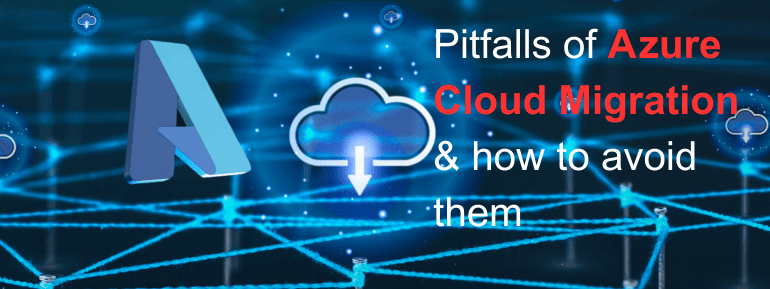To prevent issues when transitioning clients to the Azure cloud, it is crucial to steer clear of these pitfalls.
As a managed services provider (MSP), whether you are already offering cloud-based Microsoft solutions or are newly becoming a Microsoft Azure cloud partner, it is advantageous to assist your clients in initiating or enhancing their Azure endeavours. However, it is equally important to guide them towards the appropriate cloud migration method that aligns with their present and future requirements while also avoiding potential issues that may stem from incorrect approaches to the migration process.
Cloud is the new normal.
The backbone of most contemporary businesses, spanning numerous industries, comprises cloud-based solutions, accounting for over 90% of them. This trend was initially triggered by the mid-2010s shift towards digital transformation and further fueled by the COVID-19 pandemic.
It comes as no surprise that tech giants, such as Microsoft, Amazon, and Google, were quick to recognize the potential of cloud computing, even before it became a widely recognized term. Although many organizations have benefited from cloud technology, these industry leaders are now among the largest global cloud service providers (CSPs).
Due to the cloud-first mindset that COVID-19 has spurred, businesses are now seeking the assistance of MSPs to guide them in their cloud journey. Since the pandemic, more than 50% of SMBs (small- and medium-sized businesses) have raised their spending in managed services, indicating that regardless of the existing technology infrastructure, SMBs require a dependable partner they can count on to steer them in the right direction.
The fundamentals of Azure cloud migration
Azure migration involves adopting one or more solutions within the Microsoft Azure cloud service family, which may include a comprehensive range of Azure services or specific tools like Azure SQL. The details of migration, which entail moving workloads and data from on-premises data centres to cloud storage and applications in Microsoft Azure, differ from case to case, depending on cloud readiness.
This could include a scenario where a company started using Azure cloud tools, such as Microsoft Dynamics or Microsoft 365, and began migrating to Azure at that point. It may not have nearly as much heavy lifting as a small business that is late to cloud-based digital transformation and trying to catch up. Implementing a complex cloud service such as Azure DevOps Server for a partially migrated organization is also challenging. Thus, it is crucial for MSPs and their clients to have a well-coordinated migration plan in place before commencing the process.

Moreover,
When embarking on new migrations or expanding existing Azure deployments, it is important to consider the level of migration that the organization desires. Does the customer wish to establish a hybrid cloud structure and allocate resources between the cloud and on-premises infrastructure? Alternatively, are they aiming to run most of their business applications in one or more Azure clouds? It is worth noting that multi-cloud deployments are becoming more popular.
Similarly, MSPs should be aware when customers are not new to the cloud but new to Azure. For standard, a business currently using certain AWS services may consider adopting Azure Synapse to leverage its advanced data analytics features for its retail operations. Another possibility is that certain Azure tools’ price choices are preferred over those of AWS, Google, Oracle, or another CSP. These factors highlight the significance of effective communication for a successful app and data migration, regardless of the client’s stage in the migration cycle.
Azure migration strategy- options and strategies
It is evident that ensuring clients’ smooth migration to Microsoft Azure depends on several factors. Among these considerations, selecting the appropriate migration method is crucial, and some cloud specialists may even argue that it is the most significant aspect of ensuring a successful transition.
To begin with, let us discuss the primary approaches to migration:
- Lift-and-shift: Rehosting, also known as lift-and-shift, involves moving applications, data, workloads, or other resources to the cloud without any modifications. This approach may be suitable for customers with limited or no prior experience with cloud migration or those who only require a few cloud applications.
- Refactoring: During a re-platforming migration strategy, certain modifications are made to an application, but many of its features remain unaltered from the original on-premises version.
- Rearchitecting: Refactoring an app for optimal cloud-native functionality is the most work-intensive approach. Still, it is also the best option if the migrated apps need to be as cloud-optimized as possible. It essentially means rebuilding the app from scratch, potentially including data and schemas. Rearchitecting (sometimes called “rip and replace”) also makes deploying an app via microservices impossible.
- Replacing: This strategy involves migrating data from existing on-premises applications to cloud-based Software as a Service (SaaS) solutions that serve the same purpose but may be provided by different vendors. This approach is particularly suitable for simple tasks such as database migration, where a customer may transition from on-premises data centre management to an Azure SQL server.
more…
Before starting the migration process, stakeholders must determine which applications will be migrated and identify any necessary pre- or post-migration modifications. It’s important to note that some applications may be simply lifted and shifted, while others may require rearchitecting. The stakeholders should also agree on keeping any on-premises applications, having a hybrid cloud infrastructure, and deploying cloud apps using containerization, serverless architecture, or traditional virtual machines.
Determining the necessary security and data backup measures and monitoring the migration process is important. Azure provides helpful tools such as Traffic Manager, AppDynamics, and Azure Site Recovery to aid in this endeavour.
Ultimately, it’s crucial to determine the necessary security measures and backup plans before the migration and closely monitor the process. Azure provides tools such as Traffic Manager, AppDynamics, and Azure Site Recovery to facilitate migration and ensure security and data protection.
Potential pitfalls of Azure migration
Even though technology processes are designed to be reliable, no system is entirely foolproof, and migrating to Azure is no exception. It’s crucial for MSPs and their clients to be aware of the most common challenges that may arise during migration and how to address them by creating a well-defined Azure cloud migration framework well before the actual migration takes place.
Post-migration implementation problems
Migrating a cloud application without optimizing it for its new cloud environment can result in poor or compromised performance. On the other hand, refactoring an application for optimal cloud-native functionality may be beneficial in the long term. Still, it could lead to downtime that impacts daily performance in the short term.
Proper planning is crucial to minimizing issues like these. If downtime is unavoidable, team members who may be affected should be informed well in advance. Additionally, it is important to ensure that clients understand that apps rehosted in Azure may require more comprehensive retooling.
Security
Data in transit is more vulnerable to cyber threats than data at rest. During cloud migration, there may be a high volume of transitory data, making it important to protect data and workloads. End-to-end encryption is essential to safeguard data before, during, and after Azure migration. It is also recommended to advise customers to use cloud-native security features such as next-generation firewalls (NGFWs), cloud access security brokers (CASBs), and secure web gateways (SWGs) to protect their assets hosted on Azure.
Indecent vendor selection
As an MSP, it’s your responsibility to provide your customers with the cloud services they desire. If your customers become unhappy with certain vendors in the future, you may be held partially responsible. To avoid this, collaborate closely with customer representatives to identify the Azure (or Azure-compatible) solutions most appropriate for their specific requirements and can be seamlessly integrated as needed.
Knowledge gaps
Adopting a cloud strategy requires knowledge, skills, and resources. Organizations should not assume they have the in-house expertise to manage the migration process or the post-migration Azure stack. It is important to properly train staff on the cloud environment to ensure the migration process runs smoothly and efficiently. MSPs can assist in providing training to new users and organizations to enable a seamless migration process.
TOS simplifies Azure migration
While assisting a new Azure customer with their migration can be challenging, Azure cloud migration is not impossible, especially with the help of a Microsoft solutions partner like TECHOM Systems. Our experienced Cloud Experts can provide the necessary help for Azure and its associated services.
We are recognized for its trusted cloud Marketplace and its Managed IT Services and IT management that comprehensively covers the Azure platform.
Schedule a call with them to discuss your unique requirements and know more about how TECHOM Systems can help with your Azure needs; you can avail of our deployment service for Microsoft’s flagship cloud offering, led by TOS experts.













